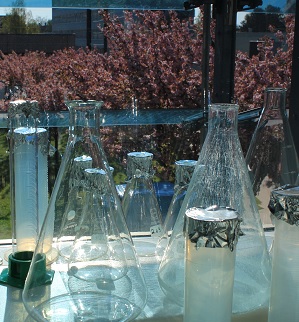Projects
Projects
The projects cover the three most relevant causes of functional folding transitions in the cell: protein-lipid, protein-nucleic acid and protein-protein interactions, with considerable overlap between the blocks.
A. Protein-lipid interactions
Within this cluster, the projects focus on protein structure changes that are caused by proteinlipid interactions. The analysed systems include bacterial and higher eukaryotic membranes, as well as model artificial membranes and monolayers. Projects cover aspects ranging from physicochemical analyses of protein-lipid interactions and membrane transport processes to functional studies of Ca2+-regulated changes of membrane protein activities or protein-lipid interactions. Five research groups fall into this category.
| A.1 | Interaction of peptides with modified amino acids with bilayer membranes and monolayers | |
| A.2 | ||
| A.3 | Biochemical and genetic characterisation of the formate channel protein FocA | |
| A.4 | The multifaceted role of calcium ions in the protein-membrane interactions of phospholipase D | |
| A.5 | ||
| Determination of the morphology of protein loaded vesicles with electron mikroscopy | ||
| Membrane remodeling by proteins |
B. Protein - nucleic acid interactions
Regulation of the biological activities of DNA and RNA, including replication, transcription and translation, are mediated by a large variety of proteins. These processes often employ macromolecular complexes such as polymerases or the ribosome, the activities of which are regulated in a highly dynamic manner. Analysis of the molecular basis of these regulative processes is the main focus of this cluster.
| B.1 | Structural analysis of the Gal4-Gal80-Gal1 transcriptional switch | |
| B.2 | ||
| B.3 | Conformational changes of viral RNA-dependent RNA-polymerases of the family Flaviviridae and their interactions with cofactors and effectors | Ralph Golbik |
| B.4 | Borna disease virus matrix protein – an RNA-membrane adaptor? |
C. Protein – protein interactions
Conformational transitions induced by homomer association or by interaction with regulatorypartners have been recognised as key reactions in many natural and pathological pathways. Such folding transitions are therefore the focus of the five teams of the final group.
| C.1 | Conformational regulation by RNA-binding cyclophilins | |
| C.2 | Influence of the polypeptide environment on poly-alanine induced fibril formation | |
| C.3 | Characterization of the calmodulin / Munc13 interaction | |
| C.4 | Conformational transitions in repeat proteins | |
| C.5 | Assembly of virus-like particles of polyoma virus: The role of VP2 in the assembly of the major coat protein VP1 | Hauke Lilie |




